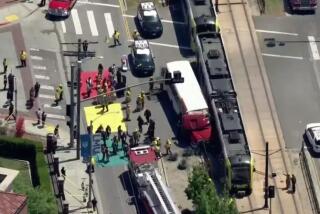Worn Wheels Cause Delays on Red Line
- Share via
Train wheels on Los Angeles’ year-old subway have worn out up to 20 times faster than designed, and problems related to the deterioration forced transit officials late this week to cut by two-thirds the number of trains in service.
Since Thursday, passengers have had to wait more than twice as long for trains during peak hours, and the trains are traveling at greatly reduced speeds. Metropolitan Transportation Authority officials said the disruptions in service are expected to continue through the weekend.
The delays began Thursday morning after a machine recently purchased by the MTA to lubricate the rails dumped too much grease onto tracks leading southwest from Union Station.
The lubrication is intended to protect against derailment and extend the life of the wheels, which records show have been wearing out much more quickly than designed since the 4.4-mile Red Line opened last January.
During the disruptions this week, the MTA has removed from service 20 of its 30-car fleet for the subway, MTA spokesman Bill Heard said.
On Thursday, the entire southwest-bound track, from Union Station to MacArthur Park, was shut down while workers attempted to remove the excess grease. On Friday, the track was reopened.
The diminished fleet and reduced train speeds have caused longer waits for passengers and crowding. Some passengers rushing from Downtown late Thursday to catch above-ground Metrolink commuter trains at Union Station said they missed their connections.
“We got all the way down into the station at Civic Center and finally a (transit) cop said: ‘You’ll have to catch a bus to Union Station.’ I couldn’t figure out what was happening and no one seemed to know,” said Russell Mun, a Municipal Court employee.
Instead of six-minute intervals during peak hours and maximum 10-minute waits at other hours, the trains have been arriving at stations every 15 minutes.
Red Line trains traveling Friday between the Metro Center station at 7th and Flower streets and Union Station were observed operating at maximum speeds of 22 m.p.h. instead of the usual 37 m.p.h.
MTA spokesman Heard said normal passenger service is to be restored Monday.
The service disruption is the most recent fallout from the excessive wheel wear, an issue brought to the attention of transit officials last spring.
The MTA has since hired two consulting firms to determine why wheels designed to last 250,000 miles often are worn out within 12,000 miles.
Officials also acknowledged that the premature wear could cause derailments. That is why the MTA in June ordered that the trains, capable of traveling 70 m.p.h., be operated at slower speeds. Lubrication of the rails began more recently.
One MTA official said that even with the lubrication, the wheels are continuing to wear prematurely. “The wear is very bad, and this affects the condition of the track,” said the official, who spoke on condition of anonymity.
A memo issued Friday by MTA operations chief Arthur T. Leahy said the lubricating machine was purchased in part because of the high number of workers needed to apply the grease-like substance by hand.
But for reasons unknown, Leahy said, the machine dumped too much grease onto the tracks. This interfered with the normal operation of the trains and caused the on-board computers to apply emergency brakes, damaging the surface of the wheels, he said.
More to Read
Sign up for Essential California
The most important California stories and recommendations in your inbox every morning.
You may occasionally receive promotional content from the Los Angeles Times.











